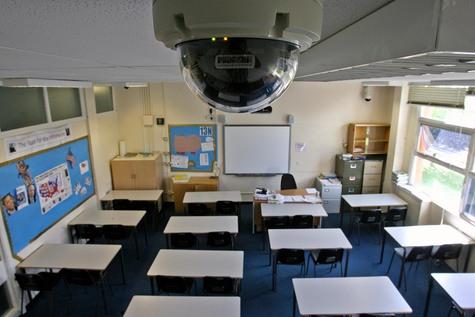Is it time to place cameras in the classroom?

Twenty-two percent of all traffic accidents in the U.S. are caused by drivers who run red lights and 39 percent of these accidents result in injuries according to the Insurance Institute for Highway Safety. Because of a shortage of human resources to monitor motorists coupled with the rise in traffic violations, accidents, fatalities, property damages and insurance hikes, cities nationwide are installing red-light cameras. Cameras allow authorities to prosecute traffic violators by detecting speeding as well as minimizing disputes regarding the violation. Motorists receive a ticket in the mail along with a photograph of the violation.
Just as cameras are being used to monitor motorists, school systems are considering the use of cameras in the classroom to monitor teachers. So the questions to be asked are: Is it time to place cameras in the classroom to evaluate teachers’ performance? What are the pros and cons of placing cameras in the classroom? Why are some parents requesting that cameras be placed in the classroom?
In 2011, the Legislature in Wyoming proposed to have cameras installed in the classrooms to measure the performance of teachers’ evaluations, however, it was rejected at the Senate level. In 2009, the Bill and Melinda Gates Foundation launched the Measures of Effective Teaching project to pilot test new strategies for measuring effective teaching through videotaping of 20,000 classroom lessons of 3,000 volunteer teachers in six urban school districts across the country. The videotaping of classroom lessons through agencies such as the National Board for Professional Teaching Standards has in the past and present been used as an instructional tool for teachers’ professional development and national board certification. The idea to have cameras in the classroom to evaluate the performance of teachers is appalling to some and appealing to others.
Some critics believe that cameras in the classroom will create an atmosphere that will catch a teacher doing something wrong whether intentional or unintentional. In addition, they believe that having cameras will add stress and take away the personal interaction of the principal, teacher and student in the evaluation process. Finally, there are concerns that cameras will violate student and teacher privacy.
Proponents of cameras in the classroom believe that cameras will help assess the effectiveness of the classroom by creating a record for principals and teachers, and thus, minimizing any dispute regarding the evaluation process. Proponents also feel that the recordings can show clear evidence for professional development in the areas of need. Other proponents claim cameras will improve instructional processes and accountability and eliminate the potential of inappropriate behavior of students and teachers in the educational environment.
As an example of camera use, in 2003 the Biloxi Public School District in Biloxi, Miss. installed cameras in all of its schools’ hallways and classrooms primarily for the improvement of safety. These schools now report lower incidents of violence and less dozing off in class, which may translate into higher student performance. Parents in Los Angeles School District vehemently requested cameras in the classrooms and other areas of the school when they learned of two teachers who were arrested for allegedly allowing lewd acts by students. The entire staff of a Los Angeles elementary school was reassigned to fully address the problem and avoid any additional surprises.
Recently, a parent in New Jersey received reports from the school claiming his autistic child was making violent outbursts and displaying disruptive behavior in the classroom. Realizing the 10 year-old child was mild-mannered and non-violent, the parent wired his son, sent him to school and listened to the audio tape once his son returned home. Consequently, the parent reported to the Cherry Hill School District his hearing on the tape of a teacher and aide bullying his son through humiliation, name-calling and repeated yelling which led to the employees being removed from the school. This is an example of a parent finding value in having a recording of the classroom setting.
While we are in a society where the use of cameras is becoming commonplace, the issue of cameras in the classroom is a very sensitive and complex matter confronting school districts especially when you consider the need for students and teachers’ privacy and the accountability of schools to maintain academic excellence and zero tolerance for inappropriate behavior in the classroom. We must tread cautiously to consider whether the pros outweigh the cons for using cameras in the classroom — whether it is for teacher evaluation, professional development or safety of students and teachers. The answer to the question is not clear cut and must be determined by the issue to be solved.
Dr. Ronald Holmes is the author of two books, “Education Questions to be Answered” and “Current Issues and Answers in Education.” He is the President of The Holmes Education Post, an education focused Internet newspaper. Holmes is the National Superintendent of Education for the National Save the Family Now Movement, Inc., a former teacher, school administrator, and district superintendent and can be reached at the following email address: [email protected].

